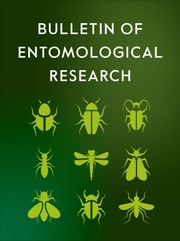Article contents
Assessing the predation dynamics of three coccinellid species on Myzus persicae (Sulzer): a functional response perspective
Published online by Cambridge University Press: 09 June 2025
Abstract
Understanding of predators functional responses is critical in assessing their efficiency as biological control agents. This study investigates the functional responses of three coccinellid predators Scymnus posticalis Sicard (Coleoptera: Coccinellidae), Platynaspis saundersi Crotch (Coleoptera: Coccinellidae), and Pharoscymnus horni Weise (Coleoptera: Coccinellidae) against varying densities of the prey aphid, Myzus persicae (Hemiptera: Aphididae) under controlled conditions (25 ± 1°C temperature, 70 ± 5% relative humidity and 14 L:10D photoperiod). Predation trials across different prey densities were performed with these adult coccinellid predators. Logistic regression analysis confirmed a Type II functional response for all the three species used in the experiments. Among the three, S. posticalis showed a superior predatory efficiency, with the highest attack rate (a) (0.0994 h−1), shortest handling time (Th) (0.5016 h) and a maximum theoretical predation rate (K) of 48.76 aphids. P. saundersi and P. horni showed lower predatory parameters, positioning S. posticalis as the most efficient predator. These findings underscore S. posticalis as a promising candidate for biological control of M. persicae, with a clear advantage in predation metrics over P. saundersi (a = 0.0876 h−1; Th = 0.5193 h; K = 48.27 aphids) and P. horni (a = 0.0695 h−1; Th = 0.5316 h; K = 47.97 aphids). However, further field validation is essential to assess its real-world efficacy, considering environmental variability and complex ecological interactions.
Information
- Type
- Research Paper
- Information
- Copyright
- © The Author(s), 2025. Published by Cambridge University Press.
References
- 2
- Cited by


